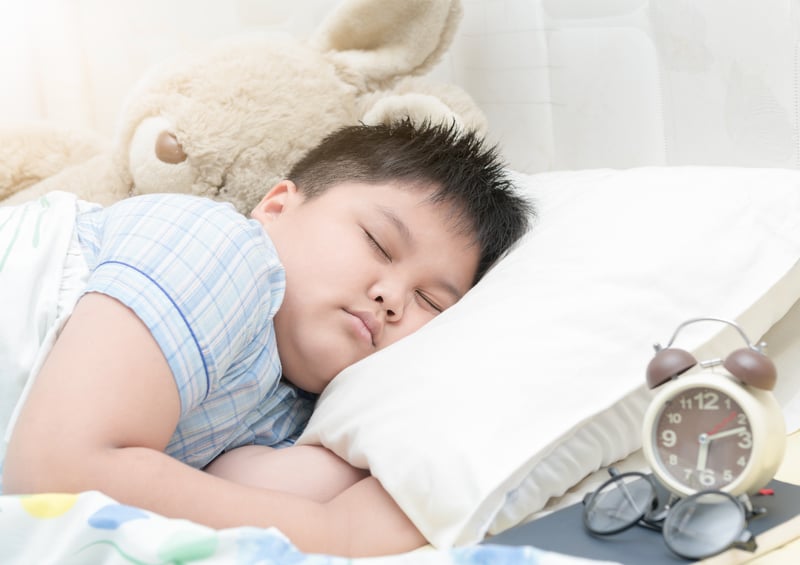Get Healthy!

- Amy Norton
- Posted March 27, 2023
Sleep Apnea in Childhood Could Affect Developing Brain
Teenagers with the nighttime breathing disorder sleep apnea may have brains that look a little different from their peers', a new study suggests.
Researchers found that among nearly 100 teens who underwent brain scans, those with obstructive sleep apnea (OSA) tended to have thinner tissue at the brain's surface, and some signs of inflammation in a brain area key to memory and learning.
Exactly what those brain structure differences mean is not yet clear, said senior researcher Dr. Raanan Arens, chief of respiratory and sleep medicine at Children's Hospital at Montefiore in New York City.
But the findings -- recently published in the journal Sleep -- do suggest that OSA can lead to observable alterations in kids' brains.
Studies estimate that anywhere from 1% to 5% of children have obstructive sleep apnea, a disorder in which tissues in the throat constrict during sleep, causing repeated stops and starts in breathing. Loud snoring is the most obvious symptom, but daytime sleepiness and attention problems are also red flags.
Those breathing interruptions can happen many times per hour, Arens said. And when breathing stops during sleep, the brain "wakes up" a little.
So OSA could affect kids' brains for two broad reasons, Arens explained: It repeatedly disrupts the brain's oxygen supply, and it deprives kids of the deep "restorative" sleep necessary for healthy brain development and functioning.
To dig deeper, Arens and his colleagues recruited 98 teenagers to undergo MRI brain scans: 53 had OSA and were overweight or had obesity; the other 45 were in the same weight range but free of sleep apnea. (Children of any weight can develop OSA, but obesity is a risk factor.)
The researchers focused on whether the two groups of kids showed any differences in the thickness of the brain's cortex (its outermost layer) or the structure of the hippocampus -- a brain area involved in memory and learning.
On the whole, the study found, teens with OSA had a thinner brain cortex and a larger volume in part of the hippocampus (which could indicate inflammation or swelling), compared to kids without the disorder. And the more severe the apnea condition was, the greater those brain differences were.
The big question is whether the structural brain differences translate into problems with memory or learning, or emotional or behavioral difficulties.
"This study specifically helps advance knowledge in the area of brain consequences -- cortical thinning and hippocampus volume -- from obstructive sleep apnea in teenagers," said Dr. Shalini Paruthi, a spokeswoman for the American Academy of Sleep Medicine who was not involved in the study.
"Larger studies with many more children with OSA may help further clarify how changes seen on MRI affect learning, attention, mood, academic performance and more," said Paruthi, who is also medical co-director of St. Luke's Sleep Medicine and Research Center in Chesterfield, Mo.
Another important point is that the teenagers with OSA in this study had not yet received treatment for it, Arens said. Ongoing research is looking at whether treatment changes any of the brain differences seen on MRI.
In children, sleep apnea commonly stems from chronically inflamed tonsils or adenoids (tissues high in throat). In those cases, surgery to remove the tissue is the standard treatment, Arens said.
In other cases, kids may need to sleep with a device that keeps the airways open by gently blowing air through a mask worn over the nose.
While it's unclear what the brain differences seen in this study might mean for kids' daily lives, it is known that untreated sleep apnea can leave children tired and irritable during the day. They may show attention, learning and behavioral problems that look similar to attention deficit hyperactivity disorder (ADHD).
Both doctors said that if parents notice possible signs of OSA in their child -- loud snoring at night, or daytime sleepiness and problems with learning or behavior -- they should see their pediatrician.
Some kids, Paruthi said, may need a referral to an ear-nose-throat specialist to see whether the tonsils and adenoids are crowding the airways. Other children may need an evaluation by a sleep medicine specialist to diagnose and treat the problem.
More information
The Sleep Foundation has more on children and sleep apnea.
SOURCES: Raanan Arens, MD, chief, respiratory and sleep medicine, Children's Hospital at Montefiore, and professor, pediatrics, Albert Einstein College of Medicine, New York City; Shalini Paruthi, MD, medical co-director, St. Luke's Sleep Medicine and Research Center, Chesterfield, Mo.; Sleep, March 2023

